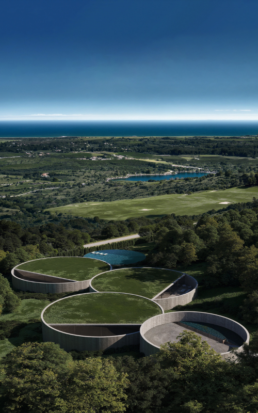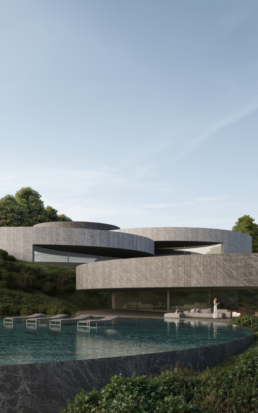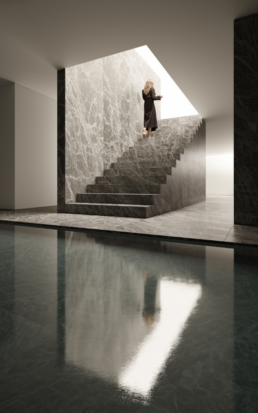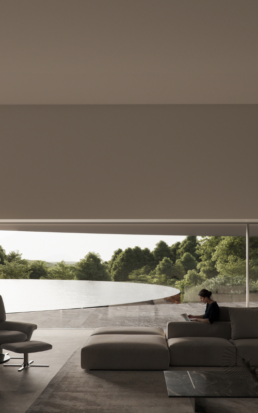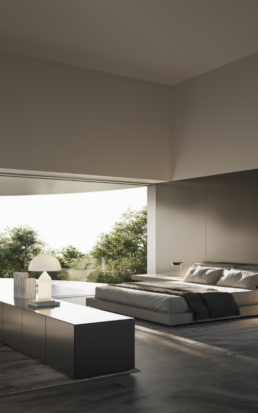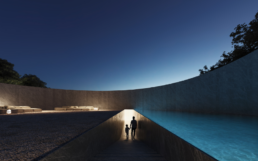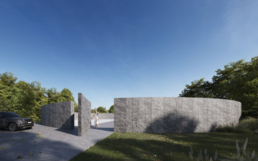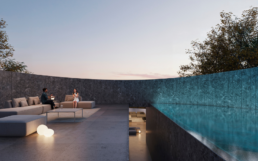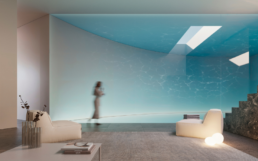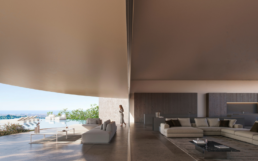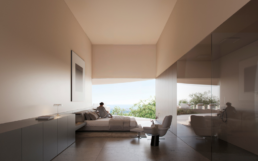New Project | Villa Noon, in La Reserva de Sotogrande
02/06/2025
In a landscape defined by its topography, Villa Noon is respectfully integrated into the terrain, using the natural slope to open each volume toward a unique horizon.
The layout of the house, fragmented into five circular volumes, responds to the desire to fully blend with the environment, seeking visual continuity with the surrounding nature without creating a disruptive footprint in the landscape.
Each of these volumes includes a front terrace that offers sun protection and a rear patio that provides shelter from the prevailing winds. This circular geometry not only optimizes orientation but also softens the volumetric impact, allowing the architecture to engage with the landscape in a measured and restrained way.
The exterior materiality, made from local Sierra Elvira stone with its grey tones and white veins, gradually blends with its surroundings. Over time, this natural texture will integrate into the site, as if it were part of the terrain itself.
Access to the villa is defined by a large open-air foyer, framed by a curved wall that acts as a threshold between the exterior and interior. This transitional space leads visitors through a sequence of rooms that adapt to the various levels of the terrain. The night area is located on a higher level, separate from the rest of the spaces, while the day area is situated on a lower platform, open to the landscape and in direct connection with the outdoors.
On this same level are the wellness spaces, such as the gym, which serve as a functional and spatial bridge to the independent guest pavilion. This staggered distribution preserves the privacy of each area while maintaining a fluid spatial continuity throughout the entire complex.
The home achieves energy self-sufficiency through a combination of aerothermal and geothermal systems, generating a surplus of electricity. In addition, it incorporates an atmospheric water harvesting system that extracts moisture from the air for domestic use.
To reduce water consumption in the garden, strategies include the use of native plant species grouped by water needs, natural mulching to reduce evaporation, and a drip irrigation system that activates only when necessary. Green roofs improve insulation and capture rainwater, while infiltration trenches (swales) filter and direct stormwater. Permeable surfaces and cisterns complete the system, enabling the collection and reuse of harvested water.
Thanks to this set of strategies, the house also achieves water self-sufficiency—an especially relevant goal in this part of Spain, where the proximity of the Sierra de Grazalema makes the area the rainiest in the country.
We’ve always been fascinated by the way the Namib Desert beetle collects water: in an extremely arid environment, this insect tilts its body toward the wind to condense fog onto its shell, which combines water-attracting and water-repellent surfaces, allowing the droplets to roll directly into its mouth. A natural lesson in efficiency that inspires and reinforces the logic of this system.
The project echoes architectures such as Arne Jacobsen’s Leo Henriksen House or Kazuyo Sejima’s Villa in the Forest, whose circular geometries and sensitivity to the landscape have been sources of inspiration. However, unlike radiocentric solutions, in this case we opted for what we call “the squaring of the circle”: resolving the living areas with an orthogonal plan, while integrating the service spaces into the irregularly shaped zones.
Ultimately, we hope that the passage of time will allow this architecture to blend into its environment, as if it were a karstic relief.


